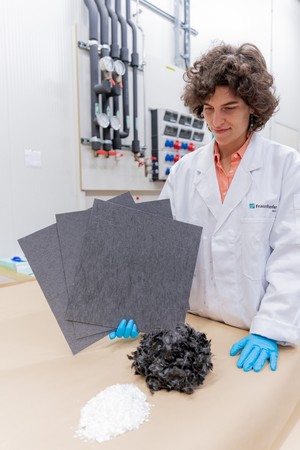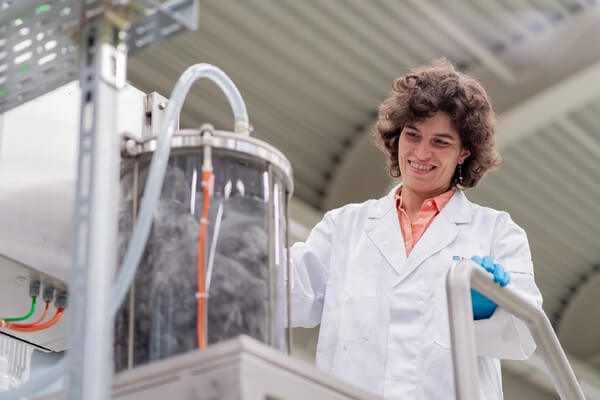Fraunhofer reduces CO2 footprint and recycles trendy lightweight carbon material
To reduce the CO2 footprint, the Fraunhofer Institute for Casting, Composite and Processing Technology IGCV Augsburg research with a state-of-the-art wetlaid nonwoven machine for recycling carbon fibers. The production processes are similar to those of a paper manufacturing machine. The crucial difference: we turn not paper fibers into the paper but recycled carbon fibers into nonwoven roll fabrics. The carbon fiber thus gets a second life and finds an environmentally friendly way in nonwovens, such as door panels, engine bonnets, roof structures, underbody protection (automotive), and heat shields (helicopter tail boom), as well as in aircraft interiors.
 "Wetlaid technology for processing technical fibers is currently experiencing a revolution following centuries of papermaking tradition," says Michael Sauer, Researcher at Fraunhofer IGCV.
"Wetlaid technology for processing technical fibers is currently experiencing a revolution following centuries of papermaking tradition," says Michael Sauer, Researcher at Fraunhofer IGCV.
Image left: Processing of hybrid nonwovens from recycled carbon fibers and thermoplastic matrix fibers (source: A3/Christian Strohmayr)
The wetlaid technology used is one of the oldest nonwoven forming processes (around 140 BC - 100 AD). As an essential industry sector with diverse fields of application, wetlaid nonwovens are no longer only found in the classic paper. Instead, the application areas extend, for example, from adhesive carrier films, and packaging material, to banknotes and their process-integrated watermarks and security features. In the future, particularly sustainable technology fields will be added around battery components, fuel cell elements, filtration layers, and even function-integrated material solutions, e.g., EMI shielding function.
Fraunhofer IGCV wetlaid nonwovens line is specifically designed as a pilot line. In principle, very different fiber materials such as natural, regenerated, and synthetic fibers can be processed, mainly recycled and technical fibers. The system offers the highest possible flexibility regarding material variants and process parameters. In addition, sufficiently high productivity is ensured to allow subsequent scaled processing trials (e.g., demonstrator production).
The main operating range of the wetlaid line relates to the following parameters:
- Processing speed: up to 30 m/min
- Role width: 610 mm
- Grammage: approx. 20–300 gsm
- Overall machinery is ≥ IP65 standard for processing, e.g., conductive fiber materials
- Machine design based on an angled wire configuration with high dewatering capacity, e.g., for processing highly diluted fiber suspensions or for material variants with high water retention capacity.
- Machine modular system design with maximum flexibility for a quick change of material variants or a quick change of process parameters. The setup allows short-term hardware adaptations as well as project-specific modifications.
Research focus: carbon recycling at the end of the life cycle

Fiber preperation for wetlaid nonwoven production (Image: A3/Christian Strohmayr)
The research focus of Fraunhofer IGCV is primarily in the field of technical staple fibers. The processing of recycled carbon fibers is a particular focus. Current research topics in this context include, for example, the research, optimization, and further development of binder systems, different fiber lengths and fiber length distributions, nonwoven homogeneity, and fiber orientation. In addition, the focus is on the integration of digital as well as AI-supported methods within the framework of online process monitoring. Further research topics, such as the production of gas diffusion layers for fuel cell components, the further development of battery elements, and filtration applications, are currently being developed.
- Source:
- Fraunhofer IGCV
- Author:
- Press Office
- Link:
- www.igcv.fraunhofer.de/...
- Keywords:
- Fraunhofer IGCV, carbon, recycling, CO2 footprint, lightweight, material, wind turbine, rotor blade, research, fibers, wetlaid line



























